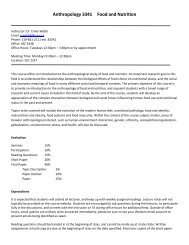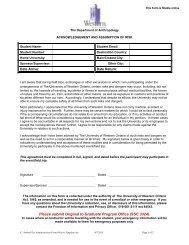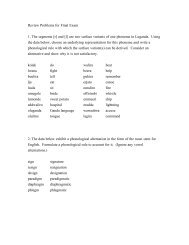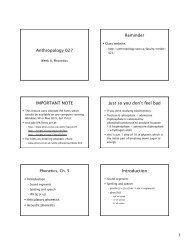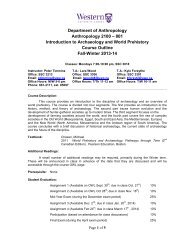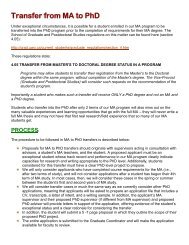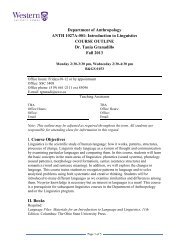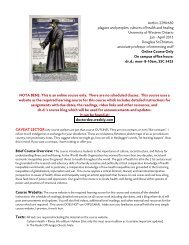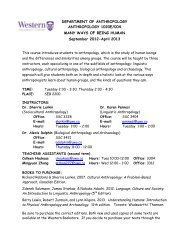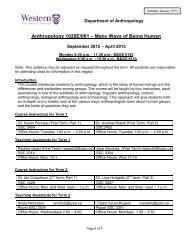Homework answers for Ch. 2 - Anthropology
Homework answers for Ch. 2 - Anthropology
Homework answers for Ch. 2 - Anthropology
- No tags were found...
Create successful ePaper yourself
Turn your PDF publications into a flip-book with our unique Google optimized e-Paper software.
<strong>Homework</strong> Answers – <strong>Ch</strong>apter 2: Morphology2c. hyperactivity: hyper + act + ive + ityhypertension actor native nativityhyperbole action passive passivityN->Adj Adj->N3A. The Spanish infinitive morpheme: -ar; the English counterpart: ‘to’B. verb->adjective morpheme: -able; means: to be ableC. verb->noun morphemes: -acion, or -ador; means: the thing caused by the verb, or theone who per<strong>for</strong>ms the action of the verb4e. *Two shevelled tourists entered the small village.- “shevelled” is a bound morpheme; although we recognize shevelled asderived from dishevelled and correctly identify dis- as a morpheme signifyingthe opposite of the word it’s attached to, shevelled only has meaning in thisone <strong>for</strong>m, dishevelled.6.Affix Words Meaning Word Class-dom Freedom, wisdom, A state or condition N, adj->N-ese Legalese, <strong>Ch</strong>inese, Lebanese Indicating origin N, adj->adj-ize Minimize, rationalize To make Adj ->Vdys-Dyslexia, dysfunctional,dystopiaImpairment, etcN, adjmega-Megabyte, megaphone,megatonSpecific measure of onemillion, generally very bigNpara-Paradox, paraphrase,paradigmBeside, beyondN12A. Morphemes indicating 3 rd person singular present: -e, -ne, -je, -i, -aB. Morphemes indicating the 3 rd pers. sing. Past: -l, -el, -alC. Morphemes indicating the 1 st pers. sing. present: -u, -nu, -ji, -im, -amD. Morphemes indicating the imperative: ø, -ni, -j, -ejE. Roots: nes, tisk, kry, saz, del
Text Questions7a. to <strong>for</strong>m an infinitive in Dutch: root + -enb. to <strong>for</strong>m the Dutch past participle <strong>for</strong>m: ge- + root + -d (this is a circumfix, not a prefixand a suffix; without both morphemes, no meaning is added)8a. nouns: -toto ‘child’, -tu ‘person’, -kapu ‘basket’, -su ‘knife’;verbs: -fika ‘to arrive’, -lala ‘to sleep’, -anguka ‘to fall’;prefixes: m- attached to singular nouns of class 1, a- attached to verbs when the subject isa singular noun of class 1, wa- plural prefix <strong>for</strong> nouns and verbs of class 1, me- prefixindicating past tense, na- prefix indicating present tense, ta- prefix indicating futuretense, ki- prefix attached to singular nouns and verbs of class 2, vi- prefix attached toplural nouns and verbs of class 2b. The verb is constructed: class/number prefix + tense prefix + verbc1. The child is falling: mtoto anaanguka2. The baskets have arrived: vikapu vimefika3. The person will fall: mtu ataanguka13Ba. I – -vungab. you (sing) – -vutitc. she/he/it – -vuqd. see – takue.work – sanaf.know – quajimag. want to – -jumah.start to – -sii.be (is/am/are) – -uj.father – ataataC. I am a teacher: ilinniaqtittijiuvungaYou eat: nirivutitI start to think: isumasivungaD. Gender is unspecified.The data available does not allow <strong>for</strong> an analysis of tense because all words are in thesame tense.The indefinite article ‘a’ is indicated by the morpheme ‘u’, attached as a suffix to thenoun.




